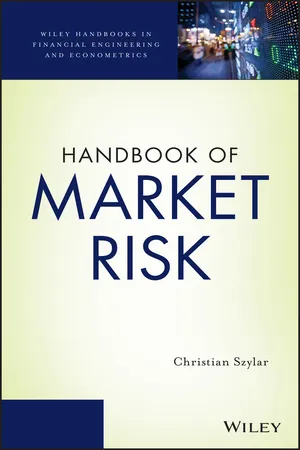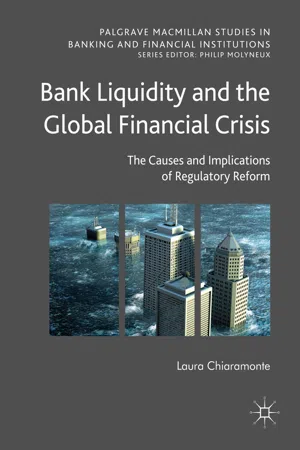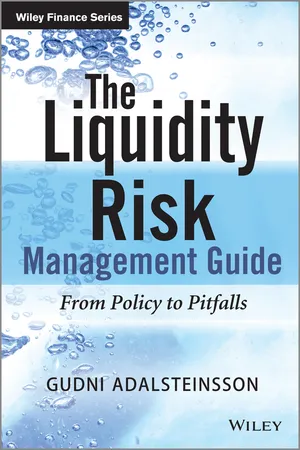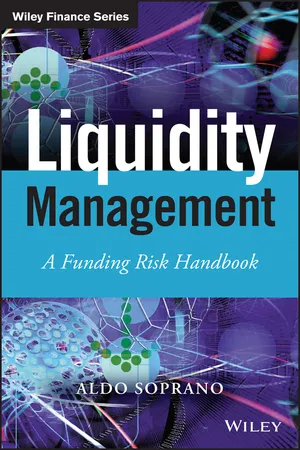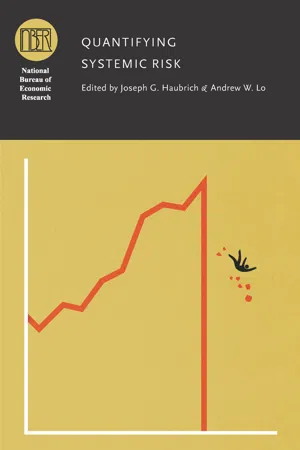Economics
Risk and Liquidity
Risk and liquidity are important concepts in economics. Risk refers to the uncertainty and potential for loss associated with an investment or decision. Liquidity, on the other hand, refers to the ease with which an asset can be converted into cash without affecting its market price. Understanding and managing risk and liquidity are crucial for making sound financial decisions.
Written by Perlego with AI-assistance
Related key terms
Related key terms
1 of 4
Related key terms
1 of 3
11 Key excerpts on "Risk and Liquidity"
- eBook - ePub
- Christian Szylar(Author)
- 2013(Publication Date)
- Wiley(Publisher)
hapter TenLiquidity RiskLiquidity is an elusive notion. Three basic definitions are commonly used: (1) the liquidity of financial instruments reflects the ease with which they can be exchanged for money without loss of value; (2) a related concept is market liquidity defined as the market's ability to trade a given volume of assets or securities without significantly affecting their prices; and (3) finally, monetary liquidity pertains to the quantity of fully liquid assets circulating in the economy. It is usually measured by a narrow or broad monetary aggregate or its ratio to nominal GDP. In this section we will focus on definitions 1 and 2. Liquidity risk in the context of banking will be covered in the chapter on Basel II/III (Chapter 13 ).We have to distinguish between the risk to funding the firm, which is usually referred to as “funding liquidity risk,” and the risk that a particular on- or off-balance sheet market or product is illiquid, which is referred to as “market liquidity risk.” The management of “funding liquidity risk” is the risk that the firm will not be able to efficiently meet both expected and unexpected current and future cash flow and collateral needs without affecting daily operations or the financial condition of the firm.” Market liquidity risk is defined as the risk that a firm cannot easily offset or eliminate a position without significantly affecting the market price because of inadequate market depth or market disruption. In this book, we will focus on the later. - eBook - ePub
- Michael B. Miller(Author)
- 2018(Publication Date)
- Wiley(Publisher)
9 LIQUIDITY RISKIn a crisis, liquidity can often make the difference between survival and disaster for a financial firm. We begin this chapter by defining liquidity risk before introducing measures and models that can help manage liquidity risk.WHAT IS LIQUIDITY RISK?
In financial risk management, when we talk about liquidity risk we are talking about the risk that a firm will not be able to buy or sell a security in the desired quantity near the current market price. In the worst‐case scenario there will be no liquidity, and the firm will not be able to buy or sell at any price.When we look at market risk, we typically assume that there is a price at which each security trades. In practice there is never really a single price. Even for very liquid securities there is always a bid‐ask spread (sometimes referred to as the bid‐offer spread). The spread is the difference between the highest price at which somebody is willing to buy (the bid) and the lowest price at which somebody is willing to sell (the ask). The quoted market price is likely either the last traded price, or the midpoint between the bid and the ask. If we want to sell a security, the bid is the best price that we will get. If we want to sell a large quantity of a security, our average price might be well below the bid. The more we try to sell, the lower the price we will have to accept. Similarly, the more we try to buy the more we are likely to pay on average.Beyond this standard definition of liquidity risk, we can also think about liquidity risk in broader terms. Financial firms must constantly balance an internal demand for liquidity (cash) against the external supply of liquidity. The more narrow definition of liquidity given in the preceding paragraph covers just one aspect of this external supply of liquidity.The Demand for Liquidity
Implicit in our narrow definition of liquidity risk is that we will need to buy and sell securities in the future. All firms require cash in order to conduct business. Farmers require cash to buy seeds and equipment and to pay laborers. Manufacturers require cash to buy raw materials, to purchase machines, and to pay workers. An investment fund, likewise, may require cash to pay trading fees, to rebalance its portfolio, or to meet the liquidity needs of investors.1 Collectively we can refer to these needs for cash as cash‐flow uses or as the internal demand for liquidity - eBook - ePub
Bank Liquidity and the Global Financial Crisis
The Causes and Implications of Regulatory Reform
- Laura Chiaramonte(Author)
- 2018(Publication Date)
- Palgrave Macmillan(Publisher)
risk . Both are discussed in the following sections, but a brief introduction is necessary.In its narrow definition, funding liquidity risk is associated solely with the liabilities side of a bank. It consists in the inability of a bank to raise funds to repay its liabilities. In this sense, funding risk is therefore the risk of an increase in the cost of funding . However, it can also be defined in broader and more general terms, taking into account both the liabilities and assets side of a bank. In this case, it refers to the possibility that the bank may not be able to settle its obligations immediately and in a cost-effective way.By contrast, market liquidity risk is the risk a bank faces when unable to convert a position on given financial assets into money or when it needs to liquidate the asset, taking a price cut, due to insufficient liquidity in the market where it is traded or to temporary malfunctioning of the market itself.Although logically different, these two risk concepts are strictly related. The need to meet unexpected cash outflows can force a bank to convert substantial amounts of its financial assets into cash. If this leads to losses, the damage arising from the liquidity risk is more severe (Banks 2005 ). The likelihood of facing both funding liquidity risk and market liquidity risk is greater the larger the maturity mismatch between liabilities (mostly short-term) and assets (mostly long-term).Apart from funding and the market liquidity risk , few scholars consider a third type of liquidity risk , central bank liquidity risk , i.e. the risk that the central bank is unable to provide liquidity to the financial system (Nikolaou 2009 - No longer available |Learn more
- Angelo Corelli(Author)
- 2019(Publication Date)
- Emerald Publishing Limited(Publisher)
Chapter 14
Liquidity Risk
Liquidity risk arises as one of the major types of risk faced by banks and financial institutions. During a recent financial crisis, the role of liquidity risk prominently emerged, as well as the importance of its proper management, as a crucial condition for the viability of banks.Liquidity risk stems from the difficulty or impossibility to market or close an investment quickly enough to prevent or minimize a loss. It is generally valid that the position of smaller size is subject to larger liquidity risk.Liquidity risk management aims at accomplishing two main objectives. On one side, it should assess, in perspective, the funding needed by an institution to meet obligations. On the other side, it must ensure the availability of cash or collateral to fulfill those needs at the appropriate time through coordination of the available funding sources under normal and stressed conditions.Investors owning long-term assets should take into account the marketability of those assets, in relation to their short-term cash needs. If assets are sold in an illiquid market, in fact, they are difficult to market, therefore carrying a liquidity risk. Liquidity risk may lower the value of certain assets or businesses due to the increased potential of capital loss.After studying this chapter, you will be able to answer the following questions, among others:(1) What is market microstructure and how can the price formation process in the financial markets be defined?(2) What is the difference between funding liquidity and market liquidity?(3) What are the main models for liquidity? How can they be classified?(4) How does regulation deal with liquidity risk and what are the main metrics developed by regulators?(5) What are the main monitoring tools for liquidity risk?Section 14.1 of the chapter gives an introduction to the functioning of financial markets, and price formation, and how liquidity issues can be identified. Section 14.2 is about models of liquidity and how liquidity risk can be managed, introducing the most popular models in the field. Section 14.3 deals with the regulatory framework, showing how liquidity risk is considered at a supervisory level, and what are the main regulatory provisions. - eBook - ePub
The Liquidity Risk Management Guide
From Policy to Pitfalls
- Gudni Adalsteinsson(Author)
- 2014(Publication Date)
- Wiley(Publisher)
In a nutshell, all funds coming into a bank belong to one of the three above-mentioned categories and only through them can a bank increase its liquidity position. As cash coming in from the businesses (money coming in from repayments) is not really manageable in the short or medium term, liquidity management is mainly focused on the other two, that is how to manage the borrowings and create liquidity with assets.4.1.2 Liquidity Risk
Having better understood the term liquidity we move to defining liquidity risk. Again, Figure 4.1 can help. Liquidity risk can be explained diagrammatically as the risk related to the previously mentioned inflows and outflows.A bank can have sources of new liquidity dry up; for instance the bank may not be able to issue new bonds or a lesser amount of new deposits are placed with the bank. On the outflow tap the risk could develop when higher than expected loan growth occurs or higher amounts of deposits are withdrawn than expected. Note that the cash flow risk can come from both sides of the balance sheet. Liquidity risk is therefore not only a function of liabilities but assets as well.When attempting to formalize the definition of liquidity risk, we again find ourselves in a universe of limited standards, but the most common definition of liquidity risk is: Liquidity risk is the inability to meet obligations as they become due and payable. This we can agree is the primary and most rudimentary definition of liquidity risk, that is the risk of default and insolvency. Some authors have expanded on the definition by adding in the currency required at the end of the definition and even pointing out the market risk element by adding expected and unexpected obligations. Both of these additions are examples of certain specific sources or types of liquidity risk but as there are many other types of liquidity risk, this book does not attempt to incorporate them into the general definition of liquidity risk. Then there are others who define liquidity risk as the inability to meet obligations as they become due and payable or only being able to do so at an unsustainable cost. - eBook - ePub
- Frank J. Fabozzi, Frank J. Fabozzi(Authors)
- 2012(Publication Date)
- Wiley(Publisher)
The obvious alternative to probabilistic approaches to the estimation of crisis-liquidity is to use crisis-scenario analyses. We would imagine a big liquidity event—a major market crash, the default of a major financial institution or government, the outbreak of a war, or whatever—and work through the ramifications for the liquidity of the institution concerned. One attraction of scenario analysis in this context is that we can work through scenarios in as much detail as we wish, and so take proper account of complicated interactions such as those mentioned in the last paragraph. This is harder to do using probabilistic approaches, which are by definition unable to focus on any specific scenarios. However, as with all scenario analyses, the results of these exercises are highly subjective, and the value of the results is critically dependent on the quality of the assumptions made.KEY POINTS- Liquidity refers to the ability to execute a trade or liquidate a position with little or no cost or inconvenience.
- Liquidity is a function of the market and depends on the type of position traded and sometimes the size and trading strategy of an individual trader.
- Liquidity risks are those associated with the prospect of imperfect of imperfect market liquidity, and can relate to risk of loss or risk to cash flows.
- There are two main aspects to liquidity risk measurement: the measurement of liquidity-adjusted measures of market risk (e.g., liquidity-adjusted value-at-risk, LVaR) and the measurement of liquidity risks per se (e.g., liquidity-at-risk, LaR).
- There are a number of easily implementable and often complementary approaches to the estimation of liquidity-adjusted measures of market risk: the constant spread, exogenous spread, and endogenous price approaches , and the liquidity discount approach.
- These approaches can produce risk estimates that differ substantially from the risk estimates obtained if liquidity is ignored.
- There are a number of approaches to the estimation of liquidity risks in noncrisis situations. These include both LaR approaches and scenario analyses.
- eBook - ePub
Market Consistency
Model Calibration in Imperfect Markets
- Malcolm Kemp(Author)
- 2009(Publication Date)
- Wiley(Publisher)
6Liquidity Theory6.1 INTRODUCTION
The extent to which individuals or markets as a whole focus on particular types of risks at particular points in time is strongly linked to how much the particular risk is in the public eye. Turbulence and lack of liquidity in worldwide money markets during 2007 and 2008 sharply focused attention on liquidity risk, including the crucial role that adequate access to liquidity plays in the effective functioning of the banking sector and related markets.Liquidity has a very direct interaction with market consistency. If all assets and liabilities that financial entities might hold were readily traded on deep, liquid and transparent markets then carrying out market consistent valuations would be conceptually quite straightforward. All that you would need to do is to source price data from these markets and then apply these prices to the assets and liabilities actually held by the entity in question. It is when markets are not deep, liquid and transparent that challenges arise.We noted in Section 3.4 that even the phrase ‘deep, liquid and transparent’ can be open to interpretation, but the basic emphasis is that of a market where participants can relatively easily trade in the instrument in question and can do so in size without moving the price very much. In this chapter we explore liquidity theory, i.e. the underlying principles involved in understanding such concepts. We then apply these insights in later chapters to identify how to take account of liquidity (or lack of it, i.e. illiquidity) when seeking market consistency.It is worth bearing in mind that liquidity theory is a less well-developed branch of financial economics than some other risk disciplines. This can be inferred from its relative lack of prominence, say, in Basel II, where it does get some mention but much less than market or credit risk and its mention is mainly in the context of stress testing. The Basel Committee sought to address this potential imbalance in subsequent documents setting out additional principles applicable to liquidity risk management, see e.g. BCBS (2008). National regulators are also focusing increasing attention on these risks, see e.g. FSA (2008b). - eBook - ePub
Banking Governance, Performance and Risk-Taking
Conventional Banks vs Islamic Banks
- Faten Ben Bouheni, Chantal Ammi, Aldo Levy(Authors)
- 2016(Publication Date)
- Wiley-ISTE(Publisher)
L is the bank’s liabilities excluding equity.9.1.1.1.1. Liquidity risk
Short-term liquidity risk is defined as a firm’s ability to pay all short-term obligations. And long-term liquidity risk is defined as a firm’s ability to pay all long-term obligations [PLE12]. The liquidity risk is the risk that a bank is unable to meet its liabilities. It is associated with the liabilities side of the balance sheet when depositors unexpectedly withdraw their financial claims. Assuming the liquidity preferences of a bank’s customers are roughly constant, the problem usually arises if there is a run on the bank as depositors try to withdraw their cash. A bank liquidity crisis is normally triggered either by a loss of confidence in the bank or because of poor management practices, or if the bank is a victim of a loss of confidence in the financial system caused, possibly, by the failure of another bank. However, if the bank experiences an unusually high deposit withdrawal rate, and lacks the cash or is unable to borrow the money quickly, it is faced with liquidating its longer term investments, possibly in a market where other banks and investment houses are also selling, pushing down prices.A bank can also experience liquidity problems on the asset side of the balance sheet, caused by large numbers of unexpected loan defaults. Banks have also been caught out granting credit lines, which they do not expect to be drawn down, but which are subsequently used by the borrowers. If an economy goes into recession relatively quickly, these banks may see firms drawing down their credit lines all at once, which will put pressure on their liquidity. There is also liquidity risk linked to off-balance sheet transactions and to a slow-down or collapse in the payments system. - eBook - ePub
Liquidity Management
A Funding Risk Handbook
- Aldo Soprano(Author)
- 2015(Publication Date)
- Wiley(Publisher)
CHAPTER 4 Liquidity Value At RiskThis fourth chapter deals with a matter requiring a dedicated book, separate from funding liquidity risk, and it is for this reason the shortest. For completion, a brief insight on the separate topic of liquidity risk, the value of risk modelling considering liquidity effects in the prices of securities, has been included. The first section introduces models and estimations for security liquidation timelines in market risk measures. The second presents the market liquidity adjusted risk modelling approach to adjust for various securities' different levels of liquidity.4.1 MARKET LIQUIDITY EFFECTS
In the context of market risk, liquidity is the risk resulting from being unable to dispose of securities and positions at a reasonable cost and in due length of time, these being the trade-off costs of the immediate disposal and the risk of keeping the position. The costs will largely depend on the size of the position compared to the normal market size of the transaction and security type, these varying from extremely liquid to the opposite extreme.4.1.1 Market volatility
The price volatility measured from the opening time to the closing is typically significantly higher than the volatility taken from one closing to the next.Infrequently traded stocks are characterized by large bid-ask spreads, conversely extremely liquid bonds, such as US Treasuries, are traded in small size and thin bid-ask ranges. The breadth of the spread depends on market supply and demand size for any specific security at a precise time: it varies depending on the securities, on the demand and supply at the time of quotation and on the markets' appetite for specific types of security. The type of order and its execution will drive the bid-ask spread. We can list different types of market orders: - eBook - ePub
Value-Based Working Capital Management
Determining Liquid Asset Levels in Entrepreneurial Environments
- G. Michalski(Author)
- 2014(Publication Date)
- Palgrave Macmillan(Publisher)
2Understanding and Measuring Financial Liquidity LevelsT his chapter presents a definition of financial liquidity and liquidity-level measurements. This chapter contains four subchapters that address the specific role of short-term financial decisions, a classification of definitions of financial liquidity , sources of information about liquidity level, and liquidity-level measurements (Lazaridis and Tryfonidis 2006; Long, Malitz, and Ravid 1993; Kieschnick, Laplante, and Moussawi 2009).Financial liquidity definition and liquidity-level measurementsHere we have an opportunity to present the author’s opinion on what assets should be financed with short-term funds and what the level of liquidity is in an enterprise (Michalski 2012a). The discussion also pertains to the issue of the dividing line between long-term and short-term decisions, with greater emphasis on the durability of their effects, rather than the decision-making speed. This section also attempts to answer the question: What are the short-term effects of operations under conditions of uncertainty and risk? The reason for the considerations in this section is the need to characterize the decisions that affect the level of enterprise liquidity. The research hypothesis of this monograph assumes that differences between more risk sensitive and less risk sensitive enterprises are seen in liquidity management. Simply because the enterprises, during financial liquidity management, take into account the differences in their risk sensitivity.2.1. Short-term and long-term financial decisions: A perspective in context of strategic and tactical decisionsCurrent financial management is associated with how a managing team’s actions have an impact on the funding needed for its activity in the short term. Considerations about the long term differ in many respects from those concerned with short term. - eBook - ePub
- Joseph G. Haubrich, Andrew W. Lo, Joseph G. Haubrich, Andrew W. Lo(Authors)
- 2013(Publication Date)
- University of Chicago Press(Publisher)
1 Liquidity Risk, Cash Flow Constraints, and Systemic FeedbacksSujit Kapadia, Mathias Drehmann, John Elliott, and Gabriel Sterne*1.1 IntroductionThe global financial crisis has served to reiterate the central role of liquidity risk in banking. Such a role has been understood at least since Bagehot (1873). This chapter develops a framework that promotes an understanding of the triggers and system dynamics of liquidity risk during periods of financial instability and illustrates these effects in a quantitative model of systemic risk.The starting point of our analysis is the observation that although the failure of a financial institution may reflect solvency concerns, it often manifests itself through a crystallization of funding liquidity risk. In a world with perfect information and capital markets, banks would only fail if their underlying fundamentals rendered them insolvent. In such a world, provided valuations are appropriate (e.g., adjusted to reflect prospective losses), then examining the stock asset and liability positions would determine banks’ health, and solvent banks would always be able to finance random liquidity demands by borrowing, for example, from other financial institutions. In reality, informational fr ictions and imperfections in capital markets mean that banks may find it difficult to obtain funding if there are concerns about their solvency, regardless of whether or not those concerns are substantiated. In such funding crises, the stock solvency constraint no longer fully determines survival; what matters is whether banks have sufficient cash inflows, including income from asset sales and new borrowing, to cover all cash outflows. In other words, the cash flow constraint becomes critical.Fig. 1.1 Funding crises in a system-wide context
Index pages curate the most relevant extracts from our library of academic textbooks. They’ve been created using an in-house natural language model (NLM), each adding context and meaning to key research topics.
Explore more topic indexes
Explore more topic indexes
1 of 6
Explore more topic indexes
1 of 4
